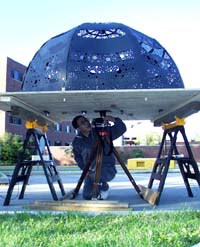Spherical Dome Helps Kentucky Researchers Study Forest Canopy
Spherical Dome Helps Kentucky Researchers Study Forest Canopy

Measuring the amount of light that penetrates through the leafy canopy of a dense forest is tricky business. That's because outdoor conditions such as wind and clouds can't be controlled. But scientists at the University of Kentucky College of Agriculture believe they have discovered a way to make forest light measurements more accurate.
The scientists have constructed an artificial forest canopy. To picture it in your mind, imagine a large, black paper umbrella with hundreds of holes punched in it. Because the size and number of holes is predetermined, the light that passes through them can be precisely measured.
"In the forest we have less control of the environment and therefore subsequently the measurement," said Calvin Liu, researcher in UK's department of forestry. "That is the reason we wanted to build a model to do the research – it gives us more control."
Liu and his associate, Lihua Wang, designed a semi-spherical dome with a six-and-a- half-foot diameter. The dome is placed atop supports about three feet high. A cloth tent placed above the dome diffuses the sunlight before the rays pass through the canopy's holes. A special "fisheye" camera is mounted in the center of the base pointed skyward. The camera, along with special light-gathering meters, record measurements that are later analyzed by computer.
Trees use the energy in sunlight for photosynthesis and other growth processes. If researchers can measure the amount of light that penetrates the forest canopy to reach smaller trees below, they can learn which trees grow best in certain locations.
"This experiment is intended to measure the light level, or energy, under the tree canopy," said Liu. "Eventually we will be able to use the newly-gained knowledge to learn how to manage forests, such as planting suitable trees in a particular forest environment."
Liu said for forestry professionals, obtaining reliable information on forest canopy and light levels is important for selecting suitable trees, adjusting stand density, and preventing soil and water loss.
Professors Liu and Wang said their goal is to understand forest canopy in an objective way by being able to repeat their measurements in a consistent way over time.